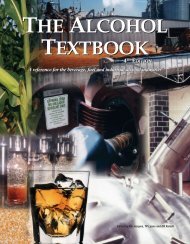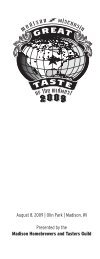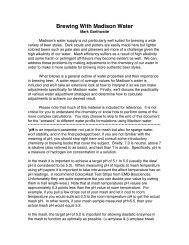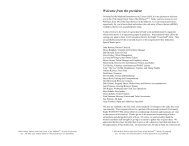The Compleat Distiller
The Compleat Distiller
The Compleat Distiller
Create successful ePaper yourself
Turn your PDF publications into a flip-book with our unique Google optimized e-Paper software.
THE COMPLEAT DISTILLER 30<br />
<strong>The</strong> Immersion Element<br />
An immersion element is mounted through the side of a boiler<br />
and is in direct contact with the liquid. Electric water heaters<br />
use immersion elements. If the element is larger than needed,<br />
it will require direct and sophisticated power control to avoid<br />
surge boiling. A thermostat in the boiler will NOT prove<br />
satisfactory. (<strong>The</strong>rmostats work in water heaters because they<br />
operate well below the boiling point).<br />
Fig. 3-7<br />
Indirect Heating<br />
An indirectly heated boiler is supplied with heat that is generated elsewhere, and then transferred to the<br />
boiler in a well-controlled manner. Frequently, the laws of physics control the temperature and the rate<br />
of heat transfer (for example, you cannot provide more than 100ºC with hot water. This prevents<br />
burning in cooking, and is particularly suitable for processing botanicals or thick mashes, which might<br />
be ruined by higher temperatures). <strong>The</strong> two main methods of indirect heating are jackets and coils.<br />
<strong>The</strong> Bath or Jacket<br />
<strong>The</strong> boiler is held inside another container that holds heated<br />
liquid or steam. <strong>The</strong> arrangement can be two separate pots (like<br />
a double boiler), or a shroud or channel permanently mounted to<br />
the outside of the boiler. <strong>The</strong> jacket can be directly heated itself<br />
(again, like the common double boiler), or fed with hot liquid or<br />
steam from a separate boiler. Jacketed heating vessels are very<br />
common in industry.<br />
Fig. 3-8<br />
Indirect heating<br />
A coil of tubing is mounted inside the boiler, in direct<br />
contact with the liquid. Hot liquid or steam flows through<br />
the coil, heating the boiler’s contents. This arrangement<br />
requires a separate heat source, and is also common in<br />
industry. This is equivalent to an immersion element, but<br />
the rate of heat transfer and the highest temperature the<br />
boiler’s contents are exposed to tend to be lower.<br />
Fig. 3-9









